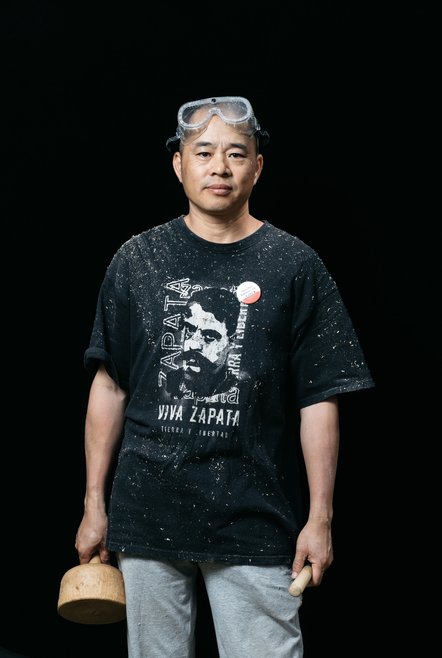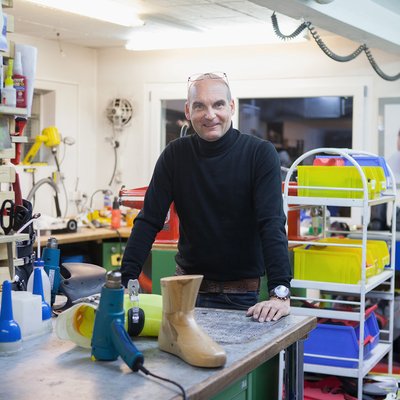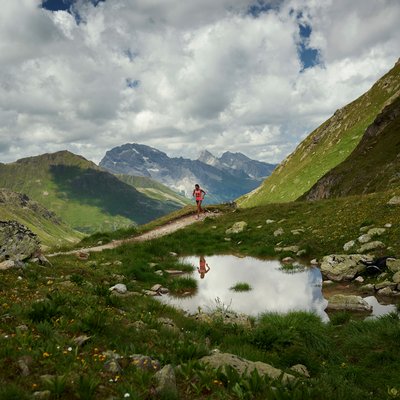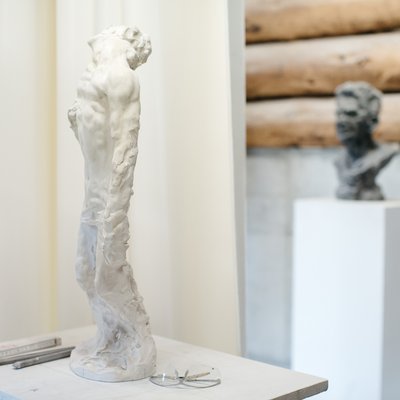The Summer Of Sculptures
Chain saws, logs and safety glasses at the International Sculpture Symposium in Davos : where art is being made, things can get messy.
Neli Hristova, a sculptor from Bulgaria, stands about two metres away from her sculpture in the making. Dressed in an army green overall, smoking a thin cigarette, she takes a small step forward, squints and uses the thumb and forefinger of her right hand to measure her figure's proportions. Then she takes two steps back, crosses her arms, takes a drag, takes another step forward, then back again, moves to the left and becomes so lost in thought that she nearly stumbles over the helmet and protective visor she wore five minutes ago. It protects her from the wood dust that spreads as soon as she revs up her massive chain saw and harshly carves her sculpture to life from the nearly three metres of larch wood in front of her. The Sculpture Symposium takes place on a patch of green next to Seehofseeli, a pond in the center of Davos. Here, people can watch in 'real time' how 13 sculptors from Bulgaria, China, Spain and Switzerland transform logs of larch wood into beautiful sculptures.
Why do you do this?
Neli is one of three women sculptors taking part in this year's symposium, alongside ten male colleagues. It's the third day of the open-air symposium and everyone is working hard on the realization of the idea that brought them here. This year marks the eleventh anniversary of the international event that takes place on the public area around the Seehofseeli in Davos. The concept is always the same: There's a set theme to which artists from all over the world respond with their sculptural ideas. Valérie Favre Accola, co-host and founder of the symposium together with local sculptor Andreas Hofer, explains how the specialist jury selects the following year's participants: "Can the idea be realized within one week? How is it tied to the theme? And finally, how innovative is it?" This year, approximately 70 artists applied. This year's theme quotes Irish literary Nobel Prize laureate George Bernard Shaw, among others: "You see things as they are and ask, "Why?" I dream things as they never were and ask, "Why not?"" – Not what I have, but what I do, is my kingdom." The quotes could also be applied to the symposium itself, as Valérie Favre Accola explains: "People always ask: Why do you do this? Why do you invest so much passion into a project that barely yields profits while requiring so much work? The quotes sum up the answer: It's not about material gain – the artists create their own kingdom in their works." These kingdoms couldn't differ more. No wonder, the themes allow a host of interpretations for each of the thirteen artists who are all from different cultural and personal backgrounds. The theme is usually a literary or philosophical quote, once it was a piece of twelve-tone music describing the sound of falling rain.




Open-air networking for artists
A sign at Xavier Escala's temporary open-air workplace explains why two large red serpents will coil around his figure when it's done. The two snakes represent the duality that comes with the capacity of the human mind to imagine and realize things. Not only good or beautiful things can come of our talents, but also negative ones such as the atomic bomb. The Spanish artist, who lives near Barcelona, most enjoys "the fresh air, the surrounding landscape with its mountains and the perfect Swiss organisation." He adds: "And also the opportunity to exchange ideas with others and to learn from them."
The idea of networking has played an important role from the start: "The sculptures are not judged by any jury and the prize money is distributed evenly among all participants. That allows a very positive atmosphere to develop. The artists help each other, exchange ideas about certain techniques and find inspiration for new works. One time, I watched an artist rediscover the technique of charring wood – in the following years he charred all his sculptures. It was one of the most rewarding moments because it showed me how well the interexchange works," Valérie elaborates.
143 sculptures have been made since 2004, many of which were sold at good prices – one even fetched 60. 000 Euros! The artists appreciate the relaxed atmosphere and also enjoy that the symposium is truly about them and their art. They live in nice hotels and when they're missing something, one of the many helpers will get whatever they need for them. The artists are invited to numerous gatherings and events outside the studio, but are not obliged to attend if they don't want to. The International Sculpture Symposium Davos enjoys an excellent international reputation, not least thanks to its breath-taking setting in the mountains. "The Alps are so inspiring, even their colouring. We traditionally enjoy hosting and want to extend our welcome to artists," Valérie Favre Accola smiles. She has been a key figure in establishing Davos as a place for artists and art lovers. "Many come as sculptors and leave as friends," she adds happily.
Art in real-time
Qian Sihua is busy filing a large head of a child that he carved from the log of Davos larch wood. It's still 'only' the head of a boy, but in a few hours there will be a metal bubble in his mouth, as the sketch at Qian's workplace shows. The bubble contains Qi, the force of life. In order for the bubble to retain its perfect shape, it mustn't have too much or too little Qi inside it – Qian Sihua's metaphor for the importance of balance. The artist, who has been sculpting since he was a child, treats the larch wood with special respect: "I strive to preserve as much of this old wood's beauty, even if it means adjusting my idea a bit."

Theories can't always be put into practice as they were intended, but according to Valérie Favre Accola, that's what makes everything so interesting. Unlike a museum or regular exhibition, the audience – ranging from mountain bikers clad in neon-coloured functional wear to relaxed grandparents with small children, to tourists from the world over – can experience in real time how an artwork comes into being. They can follow the process day by day and can see how much hard, physical work it can take to make art. Maybe one or the other will recognize a chain saw or other tool that they have in their garage at home. "Having something in common allows a wholly whole new understanding of art and it's wonderful to watch it develop," Valérie beams. Her joy in the project cannot be missed.
That dreams allow us to fly without lifting our feet from the ground is what Neli Hristova wants to show with her sculpture. Watching Valérie Favre Accola overlook the vibrant area where all 13 artists are busy at work quickly evokes the thought that she can identify with Neli's idea quite well.
Text: Martha Miklin // friendship.is
Photos: Ian Em // friendship.is
Oct. 24, 2016






















